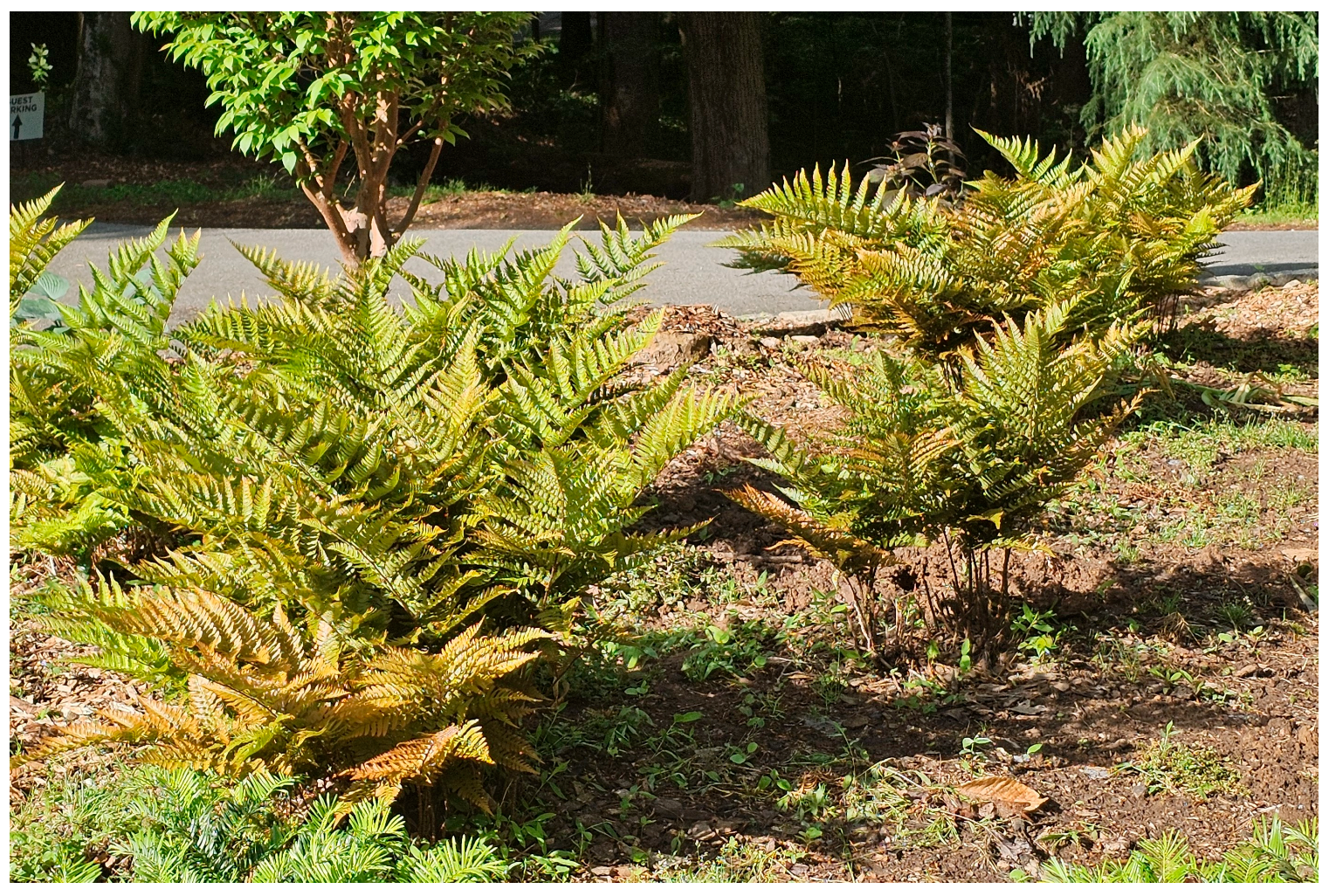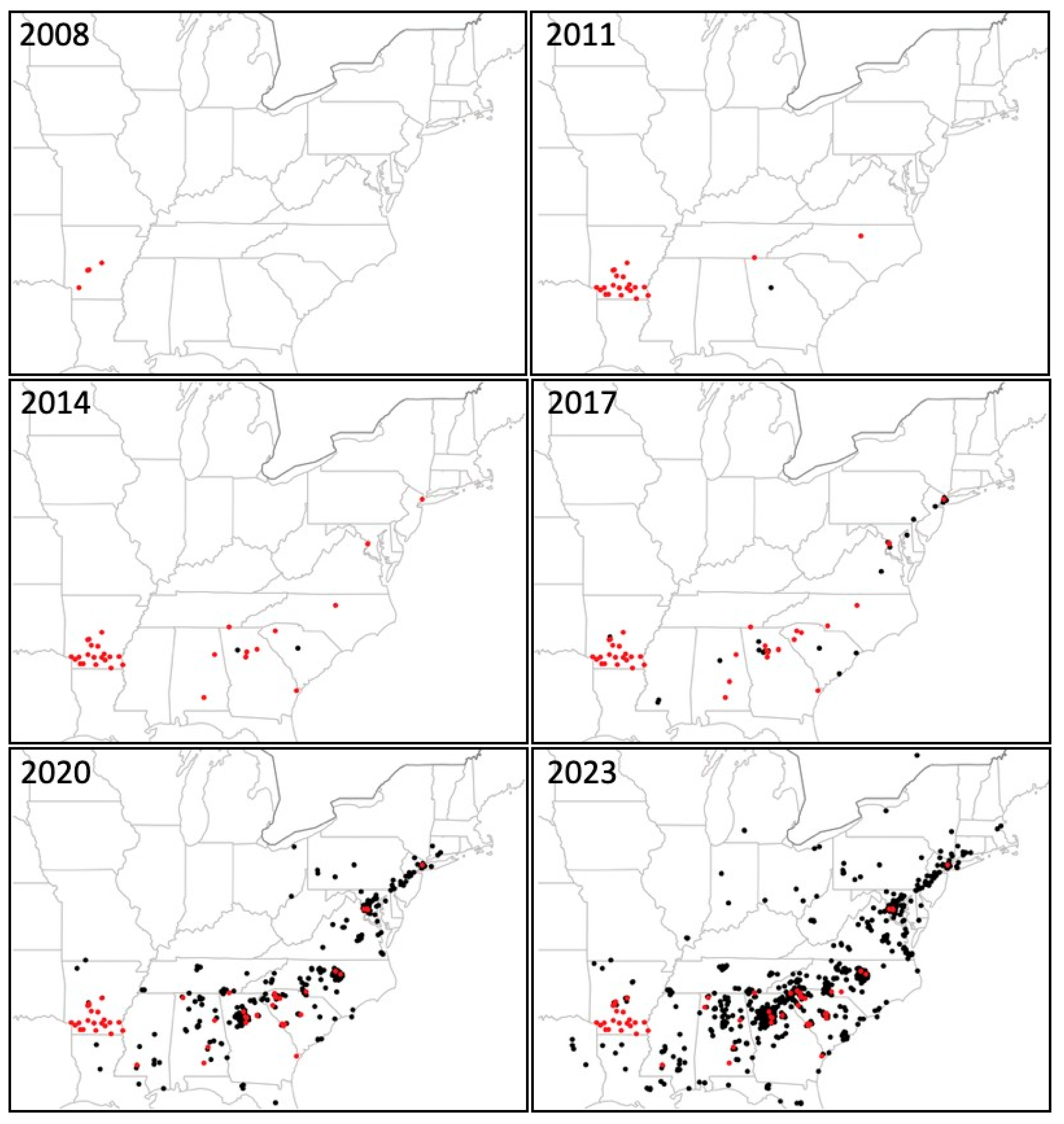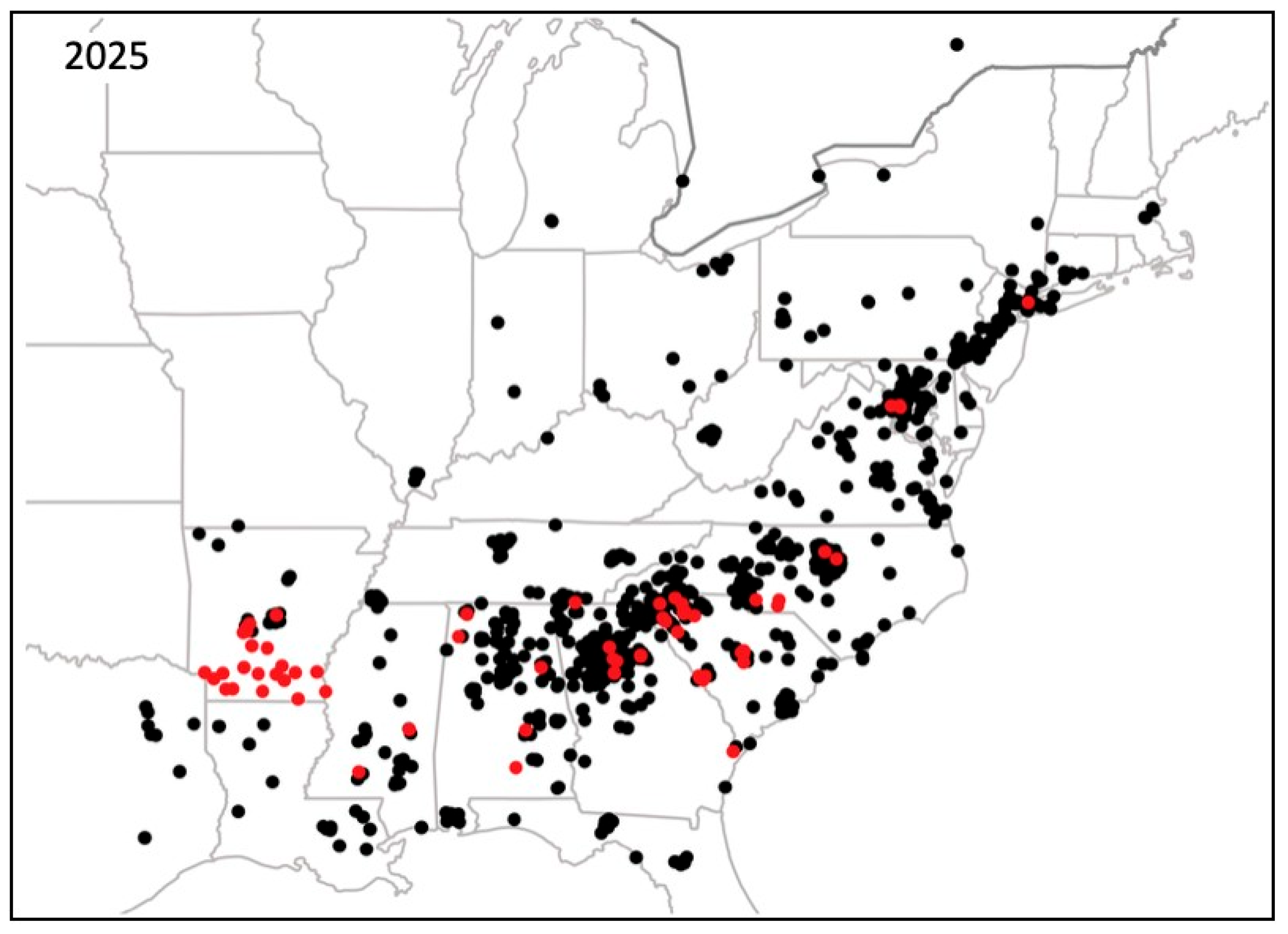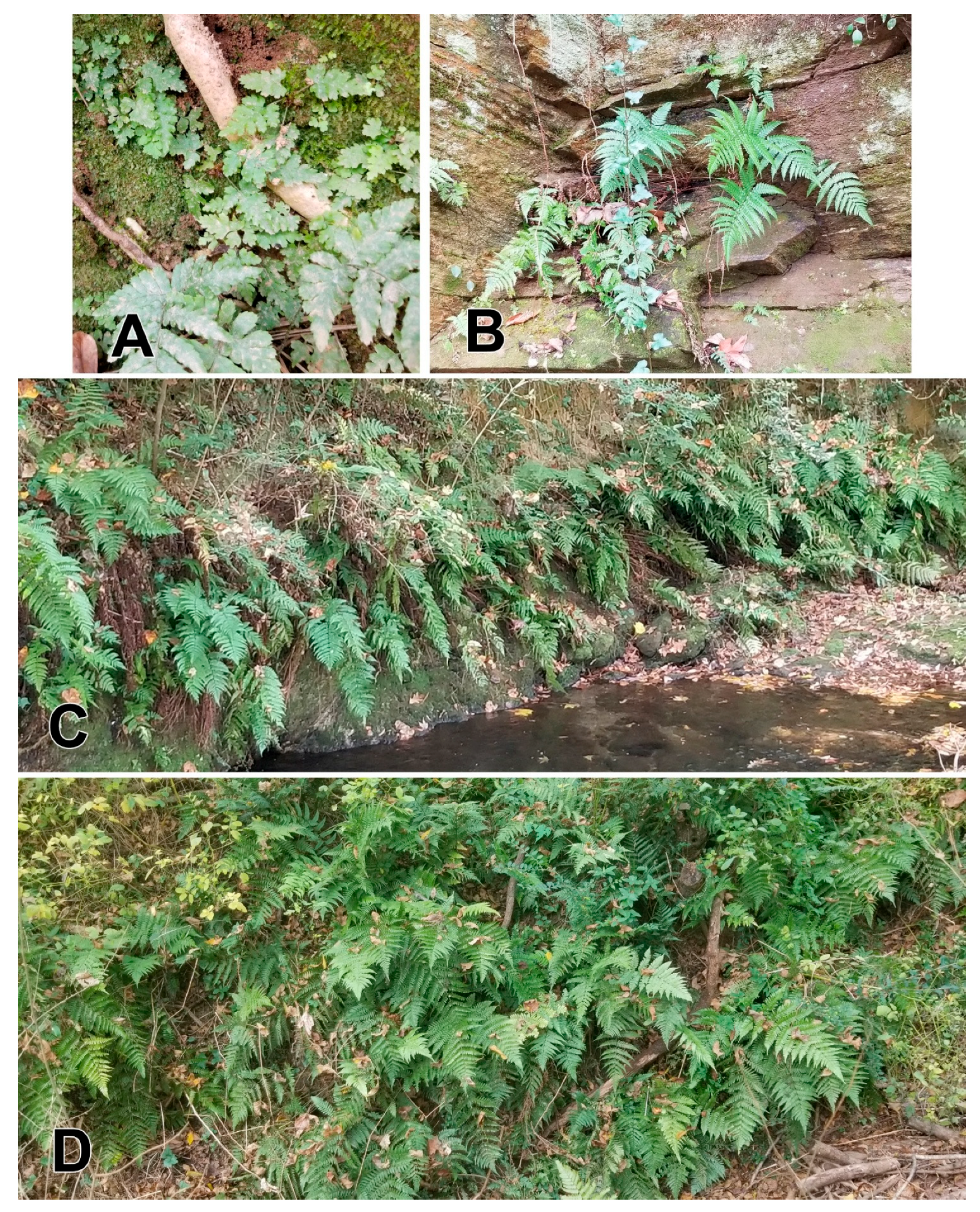The Remarkable Increase in the Invasive Autumn Fern, Dryopteris erythrosora, One of the World’s Most Marketed Ferns, in Eastern North America
Abstract
1. Introduction
2. Results
3. Discussion
3.1. Study Methods
3.2. Prior Collections of Naturalized Autumn Fern
3.3. Prior Research on Autumn Fern’s Naturalization
3.4. Market Influence on the Naturalization
3.5. Biological Influences on the Naturalization
3.6. Potential to Spread
3.7. Significance of This Naturalization
3.8. Potential Actions for This Naturalization
4. Materials and Methods
5. Conclusions
Author Contributions
Funding
Data Availability Statement
Acknowledgments
Conflicts of Interest
References
- Beaury, E.M.; Patrick, M.; Bradley, B.A. Invaders for sale: The ongoing spread of invasive species by the plant trade industry. Front. Ecol. Environ. 2021, 19, 550–556. [Google Scholar] [CrossRef]
- Pemberton, R.W.; Liu, H. Market time predicts naturalization. Ecology 2008, 69, 69–80. [Google Scholar]
- Johnson, M.D. Measuring habitat quality: A review. Condor 2007, 109, 489–504. [Google Scholar] [CrossRef]
- McCulloch-Jones, E.; Kraaij, T.; Crouch, N.; Fritz, H. The effect of horticultural trade on establishment success in alien terrestrial true ferns (Polypodiophyta). Biol. Invasions 2021, 23, 358–596. [Google Scholar] [CrossRef]
- McCulloch-Jones, E.; Kraaij, T.; Couch, N.; Faulkner, H.K. Assessing the invasion risk of traded alien ferns using species distribution models. NeoBiota 2023, 87, 161–189. [Google Scholar] [CrossRef]
- Wyatt, R. The spread of five nonnative ferns in Georgia. Am. Fern J. 2020, 110, 95–111. [Google Scholar] [CrossRef]
- Pemberton, R.W. Naturalization and spread of four of the most marketed ornamental ferns: Cyrtomium falcatum, Dryopteris cycadina. Dryopteris erythrosora and Polystichum polyblepharum. Am. Fern J. 2025, in press. [Google Scholar]
- Plants of the World Online. Available online: https://powo.science.kew.org/ (accessed on 7 May 2025).
- Mickel, J. Ferns for American Gardens; Macmillan Publishing Co: New York, NY, USA, 1994. [Google Scholar]
- Simpson, J.; Crank, D.; Witsell, C.T.; Peck, J.H. Two exotic ferns, Dryopteris erythrosora and Marsilea quadrifolia, newly naturalized in Arkansas. Am. Fern J. 2008, 98, 111–112. [Google Scholar] [CrossRef]
- iNaturalist. Available online: https://inaturalist.com/ (accessed on 7 May 2025).
- Di Cecco, G.J.; Barve, V.; Belitz, M.W.; Stucky, B.J.; Guralnick, R.P.; Hurlbert, A.H. Observing the observers: How participants contribute data to iNaturalist and implications for Biodiversity Science. BioScience 2021, 71, 1179–1188. [Google Scholar] [CrossRef]
- Delisle, F.; Lavoie, C.; Jean, M.; Lachance, D. Reconstructing the spread of invasive plants: Taking into account biases associated with herbarium specimens. J. Biogeogr. 2003, 30, 1033–1042. [Google Scholar] [CrossRef]
- Peck, J.H. History of Arkansas pteridophyte studies with a new annotated checklist and floristic analysis. Phytoneuron 2011, 38, 1–39. [Google Scholar]
- Umstead, H.; Diggs, J.T. An Ornamental plant found spreading aggressively: Potential invasiveness of Dryopteris erythrosora (Dryopteridaceae) in North America. Am. Fern J. 2018, 108, 176–179. [Google Scholar] [CrossRef]
- Weakley, A.S.; The Southeastern Flora Team. Flora of the Southeastern United States. 2023. Available online: https://fsus.ncbg.unc.edu/img/flora/FSUS_2023.pdf (accessed on 12 October 2023).
- Olsen, S. Pacific treasures for the temperate fern garden. Bull. Am. Rock Garden Soc. 1994, 52, 1771–1784. [Google Scholar]
- Hill, S.; Narizny, S. The Plant Locator: Western Region; Timber Press: Portland, OR, USA; Cambridge, UK, 2004. [Google Scholar]
- Hoshizaki, B.; Wilson, K.A. The cultivated species of the fern genus Dryopteris in the United States. Am. Fern J. 1999, 89, 1–98. [Google Scholar] [CrossRef]
- Rawlins, K.A.; Winston, R.L.; Bargeron, C.T.; Moorhead, D.J.; Carroll, R. New Invaders of the Southeast Field Guide; US Department of Agriculture, Forest Health Technology Enterprise Team: Washington, DC, USA, 2017.
- Guo, Q.; Kato, M.; Ricklefs, R. Life history, diversity and distribution: A study of Japanese pteridophytes. Ecography 2003, 26, 129–138. [Google Scholar] [CrossRef]
- te Beest, M.; Le Roux, J.J.; Richardson, D.M.; Brysting, A.K.; Suda, J.; Kubešová, M.; Pyšek, P. The more the better? The role of polyploidy in facilitating plant invasions. Ann. Bot. 2012, 109, 19–45. [Google Scholar] [CrossRef]
- Liu, H.; Stiling, P. Testing the enemy release hypothesis: A review and meta-analysis. Biol. Invasions 2006, 8, 1535–1545. [Google Scholar] [CrossRef]
- Sawamura, M.; Kawakita, A.; Kalo, M. Fern–spore-feeder interaction in temperate forests in Japan: Sporing phenology and spore-feeding insect community. Am. J. Bot. 2009, 96, 594–604. [Google Scholar] [CrossRef]
- Hoshizaki, B.; Moran, R.C. Fern Growers Manual; Timber Press: Portland, OR, USA, 2001. [Google Scholar]
- Randal, R.P. A Global Compendium of Weeds, 3rd ed.; R.G. & F.J. Richardson Publisher: Perth, Australia, 2017. [Google Scholar]
- Burghardt, K.T.; Tallamy, D.W.; Shriver, G. Impact of native plants on bird and butterfly biodiversity in suburban landscapes. Conserv. Biol. 2009, 23, 219–224. [Google Scholar] [CrossRef]
- Petersen, R.L. Towards an appreciation of fern edaphic niche requirements. Proc. R. Soc. Edinb. Sect. B Biol. Sci. 1985, 86, 93–103. [Google Scholar] [CrossRef]
- Gillman, L. Calling time on alien plantscapes. Glob. Change Biol. 2023, 29, 3539–3544. [Google Scholar] [CrossRef]
- Room, P.M.; Harley, K.L.S.; Forno, I.W.; Sands, D.P.A. Successful biological control of the floating weed Salvinia. Nature 1981, 294, 78–80. [Google Scholar] [CrossRef]
- Pemberton, R.W.; Ferriter, A.P. Old World climbing fern, Lygodium microphyllum, a dangerous weed in Florida. Am. Fern J. 1998, 84, 165–175. [Google Scholar] [CrossRef]
- Wyatt, R.; Wyatt, G.E. Lygodium japonicum (Thunberg) Swartz in the Piedmont of Georgia. Am. Fern J. 2013, 103, 188–190. [Google Scholar] [CrossRef]
- Wyatt, R.; Harris, N. More on the spread of nonnative ferns in Georgia and the Southeastern United States. Am. Fern J. 2022, 112, 36–49. [Google Scholar] [CrossRef]




Disclaimer/Publisher’s Note: The statements, opinions and data contained in all publications are solely those of the individual author(s) and contributor(s) and not of MDPI and/or the editor(s). MDPI and/or the editor(s) disclaim responsibility for any injury to people or property resulting from any ideas, methods, instructions or products referred to in the content. |
© 2025 by the authors. Licensee MDPI, Basel, Switzerland. This article is an open access article distributed under the terms and conditions of the Creative Commons Attribution (CC BY) license (https://creativecommons.org/licenses/by/4.0/).
Share and Cite
Pemberton, R.W.; Escalona, E. The Remarkable Increase in the Invasive Autumn Fern, Dryopteris erythrosora, One of the World’s Most Marketed Ferns, in Eastern North America. Plants 2025, 14, 2369. https://doi.org/10.3390/plants14152369
Pemberton RW, Escalona E. The Remarkable Increase in the Invasive Autumn Fern, Dryopteris erythrosora, One of the World’s Most Marketed Ferns, in Eastern North America. Plants. 2025; 14(15):2369. https://doi.org/10.3390/plants14152369
Chicago/Turabian StylePemberton, Robert W., and Eduardo Escalona. 2025. "The Remarkable Increase in the Invasive Autumn Fern, Dryopteris erythrosora, One of the World’s Most Marketed Ferns, in Eastern North America" Plants 14, no. 15: 2369. https://doi.org/10.3390/plants14152369
APA StylePemberton, R. W., & Escalona, E. (2025). The Remarkable Increase in the Invasive Autumn Fern, Dryopteris erythrosora, One of the World’s Most Marketed Ferns, in Eastern North America. Plants, 14(15), 2369. https://doi.org/10.3390/plants14152369




